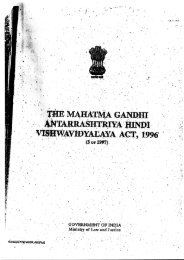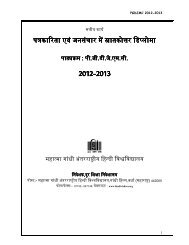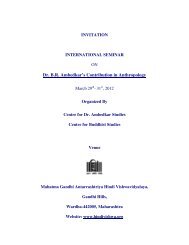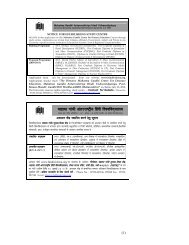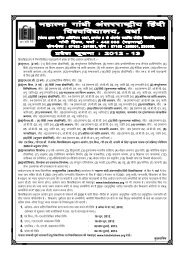memory - "Koo-koo kokum theevandi /Kooki paayum theevandi/ Rapakal odumtheevandi/Thalarnnu nilkum theevandi."The explanations in the brackets are allthe more evident in the depiction ofpopular Malayalam folk as well as filmsongs. The discourteous-sounding lines ofthe boat song that Estha sings in the picklefactory are rendered alternately in the nativelanguage and in English :Enda da korangaxha, chandi ithrathenjadu? (Hey Mr. Monkey man, why'syour bum so red?)... (ibid, 196 & 211-12). Later, the same technique is used bythe paralyzed Kuttappen while shoutingrepeatedly in his desperation : Pa pera-perapera-perakka(Mr. gugga-gug-gug-guava,)Ende parambil thooralley. (Don't shit herein my compound.) (ibid, 206). Fordepicting a song from 'President's Goldmedal winning film Chemmeen the samebracketed illustration is applied by theauthor, (ibid, 219-20). Arundhati uses thetechnique of brackets in The God of SmallThings to explain her own point of view,to make the narration effective and to showthe innermost feelings of the characters.The former translator Priya is free fromthe brackets that carried explanations bythe author. (Priya, 235). She could alsotake liberty in transcribing the folk songs,or film songs in Malayalam as if Arundhatidid it in one language.In stylistics, what is referred asdeviation, distortion etc., can be observedin Arundhati. On some occasion thisresearcher has to mention that there isfaulty spelling and notion of Arundhatiwhile describing the Kathakali and somefolk rituals of Kerala. But deliberately whenthe author had used faulty spelling on somewords like — Amayrika= America;Angshios= anxious; Verrry= very; Hell-oh=hello; Orlways = Always; Mint = Minuteetc. This can be taken as occasions if aprejudiced man and woman who try tocreate the Occidental Culture by learningEnglish. Neelabh tried similar constructionsin <strong>Hindi</strong>, whereas Priya did somealterations in phonemes with colloquialusage of Malayalam. Both of the translatorsdid free rendering to avoid such emphaticusages.Repetition of determiners, prepositions,negatives etc., are also common in theoriginal : "One corner for cooking, one forclothes, one for bedding rolls, one for dyingin."; "Past floating yellow limes...Past greenmangoes...Past glass casks of vinegar withcorks...Past shelves of pectin andpreservatives...Past trays of bittergourd...Past gunny bags... Past mounds offresh green peppercorns..."; "No milesstones marked its progress, No trees grewalong it, No mists rolled over it, No birdscircled it."Apart from these repetitions, Royuses variety of repetitions. For example :'In the lobby, the orange drinks werewaiting, the lemon drinks were waiting,the melty chocolates were waiting, TheComing Soon! Posters were waiting'...Shutup or Getout. Getout or Shutup.";"Went where they went, stopped wherethey stopped.""Nothing mattered much. Nothingmuch mattered." From the second to thefgndi •April-June 2013 :: 139
13th paragraph, Arundhati used the samesyllable P to begin with (Arundhati, 193-4), but none of the translators could adaptthis style of the original. But, the translatorsalso have their own versions that insidethose referred paragraphs, there are somewords in repetitions or alliterations, whichmake some musical re-rendering of theoriginal.In the subtitle 'Kochuthomban', thereis a recreation of cultural milieu of Keralaby depicting the 'kathakali.' The novelistmentioned two stories — one of 'Karnasapadham' (Karna's Oath) and other'Duryodhanavadham' (killing ofDuryodhan). Neelabh by mistake misspellsthe former as 'Karnasabdam' (Neelabh,234) which literally means the Oath ofKarna, may be by mistake of giving stresson the latter phrase in the compound word—Sapadham as Sapdam (replacingunaspirated d to aspirated dh). Hence thewrong transliteration appeared in <strong>Hindi</strong>.We have to make the novelist moreauthentic to define the latter story, whereshe had taken 'Duryodhanavadham' as —the death of Duryodhana and his brotherDushasana, but in practice nowhere in stagethe killing of Duryodhana took place, theversion will be complete after killingDushasana, his brother. Kathakali is atraditional art-form of Kerala depicting theMahabharata into stage-play observing thenatyasastra techniques.We can take the discourse of the funeralof Sophie Mol- ‘...Earth to earth, ashes toashes, dust to dust' (Arundhati, 7) whichderives from the English burial service. Thetext of that service is adapted from thebiblical text, genesis 3:19 (King JamesVersion). Arundhati depicted the last riteperformed by the sad priests' voices muffledwith mud and wood. Towards the end thenarrator tells that 'Her funeral killed her.The Epitaph on Mol's tombstone is alsoin italics. 'Dust to dust to dus to dus to dus'.On her tombstone it said A Sunbeam LentTo Us Too Briefly.' Both the target textshad their own transformations to this. Theconnotation that Neelabh's readers in<strong>Hindi</strong> after reading the tombstone will belittle impressed as it is human to lose her- Atyalp Kaal Ke Liye Hamen Mill EkSuryakiran'. (Neelabh, 19). Priya did afaithful rendering here by translating thisidiom literally — njangalkukshananerattekku katamayikittiya orusuryarashmi' (Priya, 23) If the word 'Lent'is carefully omitted from the originaldiction, then the suggestion of creatorcreatedrelationship will be totally lost.Hence from the believer's point, nuanceof the original that human being is beinglent by the Almighty, got lost in <strong>Hindi</strong>but retained in Malayalam. In addition,Priya kept the original English diction untranslated,to make the effect of theoriginal.There are some other occasions, wherethe Malayalam translator is devoid ofcarrying the bi-lingual interpretation ofphrases used by SL text, since Arundhaticoined most of them by her mothertongue. Contexts like describing eachalphabet in the word POLICE, the <strong>Hindi</strong>translator had to transcribe them both in140 :: April-June 2013fgndi •
- Page 1 and 2:
A Journal ofMahatma GandhiAntarrash
- Page 3 and 4:
LANGUAGEArundhati Roy in Indian Lan
- Page 5 and 6:
all is not well with the world. Ult
- Page 7 and 8:
After tallying the anubhavas mentio
- Page 9 and 10:
sustenance. If it fights shy of phi
- Page 11 and 12:
progression from Shringararasabhasa
- Page 13 and 14:
glamour and fame, I always looked a
- Page 15 and 16:
grandmother. Scolded for stealing t
- Page 17 and 18:
of his episodes and characters from
- Page 19 and 20:
The short story Najum (astrology) b
- Page 21 and 22:
India, Indianness and BuddhaDev Bos
- Page 23 and 24:
Buddha Dev Bose's writings on Tagor
- Page 25 and 26:
development of the idea of a worldl
- Page 27 and 28:
defies the set patterns of known li
- Page 29 and 30:
The Concerns of CriticismShambhunat
- Page 31 and 32:
On the basis of feudal thinking the
- Page 33 and 34:
etween the interests of different s
- Page 35 and 36:
silent about Hazari Prasad Diwedi.
- Page 37 and 38:
Imperialism. The imperialists had c
- Page 39 and 40:
conventional reformers to evaluatet
- Page 41 and 42:
expansion of knowledge emotions are
- Page 43 and 44:
unprincipled propaganda takes place
- Page 45 and 46:
drowning with shame or pride in it.
- Page 47 and 48:
made criticism a pure literary subj
- Page 49 and 50:
It is a great paradox that in an ag
- Page 51 and 52:
how much they are mixing with it. M
- Page 53 and 54:
peculiar way of protest against not
- Page 55 and 56:
Radha Worship in Hindi LiteratureL.
- Page 57 and 58:
valuable ornaments and clothes. His
- Page 59 and 60:
literature in general and Hindi lit
- Page 61 and 62:
Not only this the hunger which I go
- Page 63 and 64:
3. We the Janvadi PoetsWe are write
- Page 65 and 66:
5. A FarmerThis time paddy crophas
- Page 67 and 68:
isolated, lonely and stained with p
- Page 69 and 70:
3. A COFFIN AND A BOTTLEIn this roo
- Page 71 and 72:
The omnipresence of your super imag
- Page 73 and 74:
As I look at the black and white pr
- Page 75 and 76:
But when I touched the door of the
- Page 77 and 78:
7. LIFEThat day when I entereda mag
- Page 79 and 80:
2. TEA WITH DONNEGood Morning, dear
- Page 81 and 82:
4. HI, KRISHNA!Hi, Krishna!What’r
- Page 83 and 84:
Malbe Ka MalikMohan RakeshJai Ratan
- Page 85 and 86:
'Everything else has changed but no
- Page 87 and 88: feet, on a brick path near the open
- Page 89 and 90: ightened up on seeing Rakkha Pahalw
- Page 91 and 92: 'So what happened?''Nothing happene
- Page 93 and 94: Mad DelightMohan Rakesh was as much
- Page 95 and 96: In continuous rhythmic movements, h
- Page 97 and 98: is the silence within . . . silence
- Page 99 and 100: ehind. The man remains alone once a
- Page 101 and 102: stretching road ahead."And how much
- Page 103 and 104: the car."Tell me what do you want?"
- Page 105 and 106: "Was it necessary today itself ?" f
- Page 107 and 108: laughed father “not a morsel to e
- Page 109 and 110: Rites for The DepartedChandrakantaR
- Page 111 and 112: gazing at the swiveling waves of th
- Page 113 and 114: salutations to the Ganga : 'These p
- Page 115 and 116: He won his mukti in that instant of
- Page 117 and 118: a rush for a plank she suddenly see
- Page 119 and 120: The Voice Which was Progeny...Tarun
- Page 121 and 122: growl, blare and shouts had compell
- Page 123 and 124: Broken bamboos and thatches strewed
- Page 125 and 126: forest and open land. The man and w
- Page 127 and 128: "But I have already taken the money
- Page 129 and 130: Ramrath and Bhagirathi's fate gave
- Page 131 and 132: than their son.That boy knew this m
- Page 133 and 134: of power of the original to be tran
- Page 135 and 136: the time. "That raises a question i
- Page 137: The novelist was translating her ow
- Page 141 and 142: Referencesi. 'Arundhati Roy, transl
- Page 143 and 144: translation of literature in Englis
- Page 145 and 146: Sons published it under its Traditi
- Page 147 and 148: here that he forgot to smile.'"Afte
- Page 149 and 150: are the opulence of royalty, strugg
- Page 151 and 152: wide web (www) which has created ap
- Page 153 and 154: in it move beyond Cultural Studies
- Page 155 and 156: Prize. Wasn't it in the early years
- Page 157 and 158: deep insight into the life and work
- Page 159: 25. Ms. Kanan Jhingan, 48, Swastik



